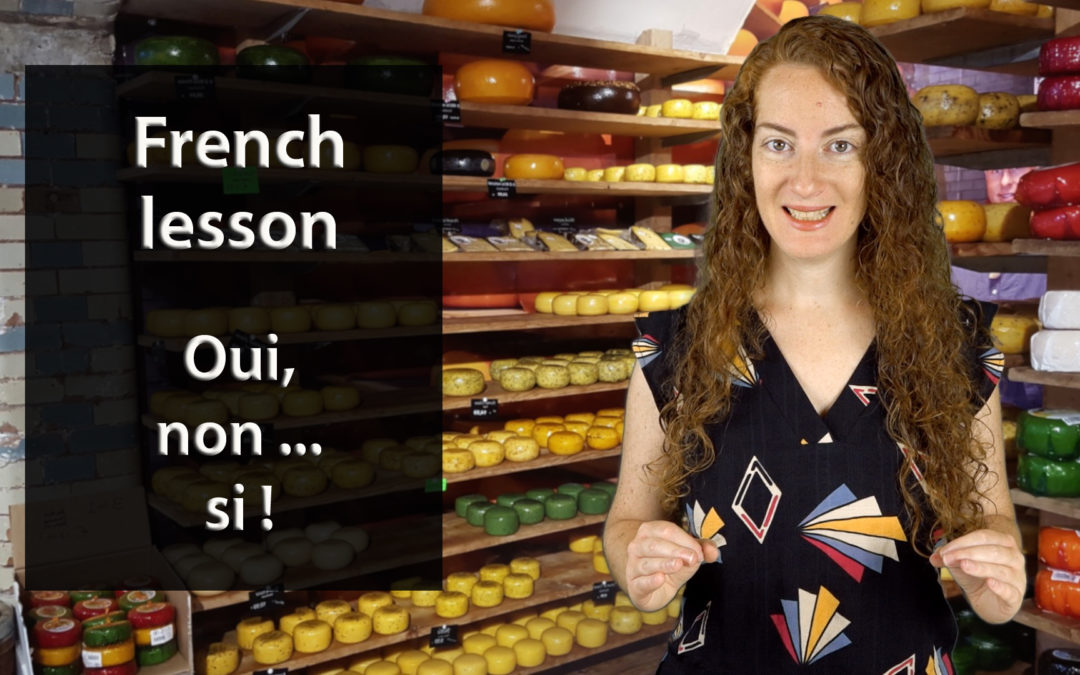


Direct pronouns in French
Direct pronouns in French

Preferences and quantity in French
Preferences and quantity in French
There are many ways to express the quantity in French and you have to pay attention to the different articles.
Tastes and definite articles
We saw in the previous lesson that if we talk about the tastes we use the definite article le/la/les
For example :
– Est-ce que tu aimes les œufs ?
In English, we would say: do you like eggs? And not: Do you like the eggs?
So be careful, it’s different in the two languages.
We answer:
Here the eggs are plural, but it is the same logic for the singular:
– j’aime le chocolat. (I like chocolate)
chocolat is masculine singular
– Est-ce que tu aimes la mayonnaise ? (Do you like mayonnaise ?)
– Non, je n’aime pas la mayonnaise. (No, I don’t like mayonnaise)
Sauce tomate et mayonnaise are feminine singular
We use the plural when we can count things : les frites, les histoires, les chats …
We use the singular when we cannot count : la mayonnaise, l’Histoire, le basketball …
Indeterminate quantities and partitive articles
Attention, what we have just explained works only for tastes and preferences.
Indeed, at the supermarket, you will buy:
– du thé
– du café
– du chocolat
– de la mayonnaise
– de la sauce tomate
– de l’eau
– des œufs
– des biscuits
In English you say : I will buy tea, coffee, water, eggs or some tea, some eggs.
So English and French are very different here.
du/de la/ de l’ are called articles partitifs because they often represent a part of something.
It’s different to say :
Je mange un gâteau (c’est un gâteaux entier) : (I eat a cake)
and
je mange du gâteau (I eat some cake).
For the negation, we use de
Je n’achète pas de chocolat, je ne mange pas de frites.
(I don’t buy chocolate, I don’t eat French fries)
Summary
So, to recap:
| masculin | féminin | voyelle | pluriel | |
| Tastes and préférences | le | la | l’ | les |
| Indeterminate quantities | du | de la | de l’ | des |
Exercises :
Complete these sentences :
Je n’aime pas … café,
Je préfère … limonade.
Je vais acheter … thé et …. gâteaux.
Je ne vais pas acheter … chocolat.
Voilà! It’s not easy but you have to practice! With time you will succeed and it will become automatic, you won’t have to think about it.
Observe these sentences:
J’aime le café, je n’aime pas le café
Je bois du café, je ne bois pas de café
Now make the same sentences by replacing café with a feminine word, a plural word and a word starting with a vowel.
IN FRENCH
Il y a plusieurs façons d’exprimer la quantité en français et il faut faire attention aux différents articles.
Les goûts et l’article défini
Nous avons vu dans la leçon précédente que si l’on parle de ses goûts on utilise l’article défini
le/la/les
Par exemple :
– Est-ce que tu aimes les œufs ?
En anglaise, on dirait : do you like eggs ? Et pas : Do you like the eggs ?
Donc attention, c’est différent dans les deux langues.
On répond :
Ici les œufs sont au pluriel, mais c’est la même logique pour le singulier.
– j’aime le chocolat. (I like chocolate.)
chocolat est masculin singulier
– Est-ce que tu aimes la mayonnaise ? (Do you mayonnaise ?)
– Non, je n’aime pas la mayonnaise. (No, I don’t like mayonnaise)
mayonnaise est féminin singulier
On utilise le pluriel lorsque l’on peut compter les choses : les frites, les histoires, les chats …
On utilise le singulier quand on ne peut pas compter : la mayonnaise, l’Histoire, le basketball, le sirop
Les quantités indéterminées et les articles partitifs
Attention, ce que nous venons d’expliquer fonctionne seulement pour les goûts et préférences.
En effet, au supermarché, vous allez acheter :
– du thé
– du café
– du chocolat
– de la mayonnaise
– de la sauce tomate
– de l’eau
– des œufs
– des biscuits
En anglais vous dites : I will buy tea, coffee, water, eggs or some tea, some eggs.
Donc l’anglais et le français sont très différents ici.
du/de la/ de l’ s’appellent des articles partitifs, car ils représentent souvent une partie de quelque chose.
C’est différent de dire : Je mange un gâteau (c’est un gâteaux entier) : (I eat a cake)
et je mange du gâteau (I eat some cake).
Pour la négation vous utilisez de
Je n’achète pas de chocolat, je ne mange pas de frites.
Récapitulatif
Donc pour récapituler :
| masculin | féminin | voyelle | pluriel | |
| Goûts et préférences | le | la | l’ | les |
| Quantités indéterminées | du | de la | de l’ | des |
Exercices :
Complétez ces phrase :
Je n’aime pas … café,
Je préfère … limonade.
Je vais acheter … thé et …. gâteaux.
Je ne vais pas acheter … chocolat.
Voilà ! Ce n’est pas facile mais il faut s’entrainer ! A force vous aller réussir et cela deviendra automatique.
Observez ces phrases :
J’aime le café, je n’aime pas le café
Je bois du café, je ne bois pas de café
Maintenant faites les mêmes phrases en remplaçant café par un mot féminin, un mot pluriel et un mot commençant par une voyelle. A vos stylos !


Oui, non, si! Answer questions.
Oui, non, si! Answer questions.
Do you know how to answer a question in French ?
Yes ?
Maybe not perfectly.
There is a subtlety you may not be familiar with: the use of the word » si ». Let’s see how it works.
Oui
There are three ways to answer a closed question in French.
The first is to answer « oui » if your answer is yes.
For example, you are asked:
– Est-ce que tu aimes le fromage ? (Do you like cheese ?)
You answer :
– Oui, bien sûr ! (Yes, of course !)
Non
If you don’t like cheese you will answer:
– Non, je déteste le fromage. (No I hate cheese)
Ok, so far so good, it’s like English: oui/non
Si
Now imagine that the question we are asking you is a little different.
The person asks you:
– Tu n’aimes pas le camembert ? (Don’t you like camembert ?)
Your answer will be :
– Si, j’aime le camembert, c’est le seul fromage que j’apprécie. (Yes, I like camembert, it’s the only cheese I appreciate)
In your opinion, why do we use « si » here and not « oui »?
That’s because it’s a negative question: Tu n’aimes pas? (don’t you like?)
So, here is the rule:
If you answer « yes » to a negative question in French, you must say « si » instead of « oui ».
So « si » does not exist only in Italian and Spanish, it also exists in French with a very particular meaning.
Examples
Let’s see other examples:
Try to answer these questions in the affirmative:
– Tu aimes les fraises ? (You like strawberries)
– Oui, j’adore les fraises ! (Yes I love strawberries)
-Tu n’aimes pas les fraises ? (Don’t you like strawberries ?)
-Si, bien sûr, j’aime beaucoup les fraises ! (Yes, of course, I like strawberries very much!)
– Tu vas au travail? (You go to work ?)
– Oui, comme d’habitude. (Yes, as usual)
– Tu ne vas pas au travail ce matin ? (You don’t go to work this morning?)
– Mais si, évidemment! (Yes, I’ll go, of course!)
If you answer « oui » to this previous question we will not understand if you mean « yes, I’m going to work » or « yes, you’re right, I’m not going to work ». So, for us, it’s not clear if we answer « oui » to a negative question.
If you want to answer « no », it’s less complicated, you always use « non » regardless of the question style.
– Tu aimes la fondue? (You like the fondue ?)
– Non, je n’aime pas la fondue . (No, I don’t like the fondue)
– Tu n’aimes pas la fondue ? (You don’t like the fondue ?)
– Non, je n’aime pas du tout. (No, I don’t like it at all.)
Here is a summary table:
| Affirmative question | Negative question | |
| You agree | OUI | NON |
| You don’t agree | NON | SI |
Be careful, there is another « si » which means « if » in English. These are two different words:
Si tu viens, on va au parc. (if you come, we go to the parc.)
This has nothing to do with answering a question.
IN FRENCH
Savez-vous comment répondre à une question en français ?
Oui ?
Peut-être pas complètement.
Il y a une subtilité que vous ne connaissez peut-être pas : l’utilisation du mot »si ». Voyons comment cela marche.
Oui
Il y a trois façons de répondre à une question fermée en français.
La première est de répondre « oui » si votre réponse est affirmative.
Par exemple, on vous demande :
– Est-ce que tu aimes le fromage ? (Do you like cheese ?)
Vous répondez :
– Oui, bien sûr ! (Yes, of course !)
Non
Si vous n’aimez pas le fromage vous répondrez :
– Non, je déteste le fromage.
Ok, jusque-là tout va bien, c’est comme en anglais : oui/non
Si
Maintenant imaginez que la question que l’on vous pose est un peu différente.
La personne vous demande :
– Tu n’aimes pas le camembert ? (Don’t you like camembert ?)
Votre réponse sera :
– Si, j’aime le camembert, c’est le seul fromage que j’apprécie. (Yes, I like camembert, it’s the only cheese I appreciate)
A votre avis, pourquoi utilise-t-on « si » ici et pas « oui »?
C’est parce que c’est une question négative : Tu n’aimes pas / don’t you like
Donc, voici la règle:
Si vous répondez « yes » à une question négative en français, vous devez dire « si » au lieu de « oui ».
Donc « si » n’existe pas seulement en italien et en espagnol, il existe aussi en français avec un sens bien particulier.
Exemples
Voyons d’autres exemples :
Essayez de répondre de façon affirmative à ces questions :
– Tu aimes les fraises ? (You like strawberries)
– Oui, j’adore les fraises ! (Yes I love strawberries)
-Tu n’aimes pas les fraises ? (Don’t you like strawberries ?)
-Si, bien sûr, j’aime beaucoup les fraises ! (Yes, of course, I like them very much!)
– Tu vas au travail ? (You go to work ?)
– Oui, comme d’habitude. (Yes, as usual)
– Tu ne vas pas au travail ce matin ? (You don’t go to work this morning?)
– Mais si, évidemment ! (Yes I go! Of course!)
Si vous répondez « oui » à cette précédente question nous ne comprendrons pas si vous voulez dire « oui, je vais au travail » ou « oui, tu as raison, je ne vais pas au travail », donc pour nous ce n’est pas clair si l’on répond « oui » à une question négative.
Si vous voulez répondre « non », c’est moins compliqué, vous utilisez toujours « non » quelle que soit le style de question.
– Tu aimes la fondue? (You like the fondue ?)
– Non, je n’aime pas la fondue. (No, I like that much)
– Tu n’aimes pas la fondue ? (You don’t like the fondue ?)
– Non, je n’aime pas du tout. (No, I don’t like it at all.)
Voici un tableau récapitulatif :
| Affirmative question | Negative question | |
| You agree | OUI | NON |
| You don’t agree | NON | SI |
Attention, il existe un autre « si » qui signifie « if » en anglais. Ce sont deux mots différents :
Si tu viens on va au parc. (If you come, we go to the parc.)
Ceci n’a rien à voir avec le fait de répondre à une question.


Verbs you often mix up in French
Verbs you often mix up in French
Savoir / connaître
C’est une erreur courante de confondre ces deux verbes, pourtant il est important de savoir les distinguer.
Vous trouverez sur certains sites des explications qui correspondent au sens du verbe : »savoir » exprime ceci, »connaître » exprime cela … Soyons francs : il n’y a pas vraiment de différence de sens entre ces deux verbes. La seule façon de les différencier est grammaticale ! Cela vous stresse ? Ne vous inquiétez pas, c’est assez clair :
– On utilise »connaître » devant un nom
– On utilise »savoir » après un verbe ou une phrase.
Par exemple :
- Je connais
ton adresse. (I know your address) - Je sais
où tu habites. (I know where you live) - Je sais
lire. (I know how to read)
Regarder / voir
Là, c’est plus facile pour vous car c’est la même chose en anglaise et en français. Cependant, beaucoup de mes élèves font cette erreur.
– Regarder = to watch, to look at
– Voir = See
Par exemple :
- Je regarde la télé. (I am watching TV)
- Je regarde les danseurs. (I am looking at the dancers)
- J’ai vu John hier. (I saw John yesterday)
- Je vois ce que tu veux dire. (I see what you mean)
Entendre / écouter
Ici aussi, il y a des équivalents en anglais.
– Entendre = to hear
– Ecouter = to listen to
Par exemple :
- J’écoute la radio chaque matin. (I listen to the radio each morning)
- Je n’entends rien. (I can’t hear anything)
Parler / dire / raconter
Ici nous avons trois verbes de sens assez proche :
– Parler = to speak, to talk to
– Dire = to say, to tell
– Raconter = to tell a story
Par exemple :
- Il parle à son voisin. (He is talking to his neighbor)
- Il parle vite. (He speaks fast)
- Il m’a dit la vérité. (He told me the truth)
- Ne dis pas ça ! (Don’t say that)
- Il raconte une histoire à ses enfants. (He is telling a story to his children)


Adverbs in French: les adverbes
Adverbs in French: les adverbes
What is an adverb ?
An adverb is a word you add to the verb (ADD-VERB) to give some information about this verb.
For example:
I walk > How do I walk? I walk rapidly.
Je marche > Comment je marche? Je marche rapidement.
Rapidement is the adverb.
Sometimes, the adverb adds an information to an adjective or another adverb. It’s not so important for you to know that.
How do we build it?
In English, most of the adverbs end with »ly » like rapidly.
In French, most of the adverbs end with »ment » like rapidement.
In that regard, many adverbs are quite similar in French and English, here are some examples:
– extremely: extrêmement
– dangerously: dangereusement
– totally: totalement
– completely: complètement
– entirely : entièrement
– remarkably : remarquablement
– terribly : terriblement
– generally : généralement
– especially : spécialement
– largely: largement
– simply: simplement
– personally: personnellement
– probably: probablement
Etc. there are a lot.
So if you don’t know an adverb in French, you can still try to use the English adverb, replacing -ly by -ment, and see if the person understands
Other type of adverbs
There is some other very frequent adverbs that don’t follow this rule.
Usually, we like to classify them into categories. The main categories are:
Adverbs of location
Ex : ici (here)
Adverbs of time
Ex : maintenant (now)
Adverbs of frequency
Ex : toujours (always)
Adverbs of quantity
Ex : beaucoup (a lot)
Adverbs od manner
Ex : bien (well)
Adverbs of logic (linking words, cause, consequence, concession or opposition)
Ex : cependant (however)
You can imagine that each category needs its own video, and I’ll do them, starting with the location adverbs that are needed from the beginner level. And you will learn all these adverbs step by step, in context.
I’ll give you more examples of these kinds of adverbs in the document below this video.
Ok! So if you are a beginner student, you can stop the video here, you have enough information to be able to progress. Try to make some sentences with some adverbs and publish them in the comments.
If you are more advanced and you want to go deeper in the understanding of the adverbs, we’ll do that now.
Construction of the -ment adverbs
I told you that a lot of adverbs use the ending -ment. But what do we put before the ending -ment?
Case 1
Usually it’s the feminine form of the adjective.
You remember that we have studied the adjective and that there is a masculine and a feminine form, contrary to the English.
So, to form the adverb, you use the feminine adjective and you add -ment.
| Masculine adjective | Feminine adjective | Adverb |
| certain | certaine | certainement |
| heureux | heureuse | heureusement |
Sometimes you need to add an accent (so the pronunciation changes a bit):
| Masculine adjective | Feminine adjective | Adverb |
| précis | précise | précisément |
| profond | profonde | profondément |
Exception:
| Masculine adjective | Feminine adjective | Adverb |
| gentil | gentille | gentiment |
Case 2
The masculine ends with a vowel, so we keep the masculine to form the adverb :
| Masculine adjective | Feminine adjective | Adverb |
| vrai | vraie | vraiment |
| absolu | absolue | absolument |
| rapide | rapide | rapidement / vite |
Sometimes you need to add an accent (so the pronunciation changes a bit):
| Masculine adjective | Feminine adjective | Adverb |
| énorme | énorme | énormément |
| intense | intense | intensément |
It’s almost the same rule as before, we just want to keep the alternance of consonant and vowels sounds, typical of the French language. As we already have the vowel at the end of the masculine so we don’t need the feminine before -ment.
Case 3
This concerns the adjectives ending with -ent or -ant. In that case the adverb is slightly different.
When the adjective ends with -ent or -ant, we remove this syllable and we replace it by -emment and -amment that are both pronounced [amã].
For example:
| Masculine adjective | Adverb | Pronunciation |
| fréquent | fréquemment | [fré ka mã] |
| évident | évidemment | [é vi da mã] |
| suffisant | suffisamment | [su fi za mã] |
Exception:
| Masculine adjective | Feminine adjective | Adverb |
| lent | lente | lentement |
Lent follows the case 1.
Here is an example of text with a lot of adverbs:
Je marche rapidement dans la rue. Les voiture roulent très vite et les vélos (roulent) lentement. J’ai vraiment besoin de faire une pause. Je m’arrête immédiatement dans un café et je commande poliment un thé et un croissant. Je mange tranquillement et je repars calmement.
Voilà! It’s finished, if you have any question don’t hesitate to ask it in the comments.
